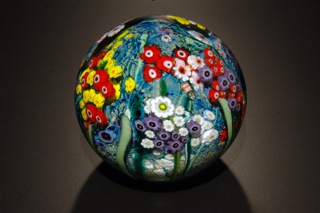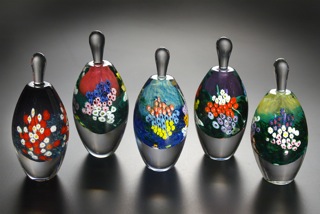By Carolyn Edlund
Artists need a cohesive, signature body of work. Create a great collection for your targeted audience.
Artists often look for ways to increase business, such as better marketing techniques, creating more income streams, or licensing their work. Another major factor that can affect your bottom line is your product line – and thoughtful development of it.
As you consider how to grow your body of work, take a look at the big picture. Are you selling one-of-a-kind pieces only? Is your price spread limited, restricting your market? Do you want to break out this year, or even explode your business by tapping into ways of selling you haven’t tried before?
Expand your sales through wholesaling
Many artists have their illustrations and artwork on products such as greeting cards, prints, hand-painted clothing, and other retail items which can be produced in volume. If you can produce in multiples, such as pottery, jewelry, clothing or other handcrafted line, prints of your work, or using your art on self-produced products, you open yourself to the world of wholesaling. If this is your choice, make sure to crunch the numbers and price your work for profit at wholesale.
Selling wholesale not only creates a huge boost in volume, but helps stabilize your business as well. There is nothing like having orders from a repeat customer base of retailers to keep regular income flowing through the door of your studio year round.
In my own experience running a production ceramic studio for twenty years, I had about 150 retail stores at any given time as active wholesale customers. Although each account was different in the frequency and volume of their orders (and there was an expected turnover of about 20% each year), it brought enormous stability, which allowed me to hire assistants and make projections each year based on a known quantity.
An added bonus is that as you develop your own book of business, you will be able to show receivables and gain the credibility to successfully apply for a business loan to expand your operation if you wish. Bankers love hard numbers, and most businesses have this kind of data. You will too.
Design your line for growth
Back to focusing on developing your product line. Plan carefully so that as you ramp up to create a new, cohesive and exciting line for your business, you will be able to:
- Open new and broader markets for your work
- Spread your price points to appeal to more customers’ budgets
- Enhance your brand
- Increase repeat sales
- Put yourself in a position to cross-sell more of your line
- Rejuvenate your business by adding lots of exciting new items
As you consider new directions for your line, make sure you are designing what you enjoy doing and would be happy to stay with. After you come up with a core look for a collection, start branching off into more related products. Necklaces need earrings and bracelets to match – and pins, hair ornaments, even ankle bracelets. Tabletop items look great in groupings. Pottery is a natural for a collection. Working in themes offers endless opportunities for collections.
Diversify your price points
If you design more than one collection, you may want to make one higher-end and one with lower prices, to catch a wider audience. Name your collections. Give them life, make them memorable. Go into your design process knowing who your target customer is, what they buy and why your work will appeal to them.
Now, let’s increase the ticket. Think pairs or sets. If you can sell several of a product rather than one because they are in a set, each sale jumps immensely. Artwork in themes should be created in series to be displayed together for a bigger ticket price. Why would you sell one kitchen-related print when you can create a set of four to be hung together? You can stress this point by not offering them as singles. And if you license your images, all the better. Art publishers love artwork in a tightly cohesive series. They know and value the power of collections.
Collections make a statement. They look good when displayed. They create a buzz. Rockstar designers know this. Start looking at the websites of artists and craftspeople you know who are successful. They all started with good ideas and expanded on their signature styles.
What designers do you know with a well-made, popular collection? What inspires you to create your own?






This is great advice for any emerging artist. Its good to have a secondary product line to help get you through the dry spells when you don’t sell any major pieces. We’d all like to be working on masterpieces, but, having supplimental sales may be the difference between being your own boss and having to hold down a less savory “day job”.
Very true! Plus, wouldn’t you rather be working for yourself producing those “secondary products” than working for someone else?
Great tips that I’ll be implementing this year. I think that I’ve just now after three years found my niche and style. I have a feeling that this year will be a good one.
Gayle, I agree that it takes a while for artists to find their style and where they are comfortable. I frequently speak to artists who have “a little of this and a little of that,” and are not sure where they want to be, or what the market is for their work. When you see an artist with a strong signature collection which is complete and works together, it’s easy to see that, isn’t it? But that takes time and a lot of effort. It’s my hope to see more artists plan and work towards strong collections which will benefit them in business.
Great article! In fact, I did a post about this article – and another one of your articles that I saw today on artbistro.
http://cinnamonpink.typepad.com/cinnamon_pink/2012/01/jumpstart-your-artistic-goals-by-checking-in-with-.html
Thank you, Darlene! The ArtBistro article that you read was taken from a post on my site called “25 Ways Artists & Craftspeople Can Market Their Work” which you can see here http://bit.ly/a4vgIi. ArtBistro is an aggregator site, so all of my articles there can also be accessed here, but they have changed the titles.
Great ideas, as usual Carolyn! I have resisted making my own mass produced products, as that really is counter to my creative process. But until I can get connected to manufacturers who may take on the production for me thru licensing, I am giving it a go. Thx or the link to the art publishers article. Gonna give that more attention…
BZTAT, Wholesale is a different world, but it’s true that it is amazingly stabilizing for a business. Some artists, such as Drew Brophy, have tried manufacturing themselves and it drove them crazy, so they prefer licensing. You can see an article on it here http://bit.ly/uKYdPw. However, other businesses can be very successful with production work. It’s a personal preference. I wish you the best!
I prefer licensing too, but it seems that one must outlay a bunch of cash to get connected to the right licensees. I have put together a decent portfolio of images, so now I need to get connected to the right folks to license them. But I can’t afford to set up a booth at one of the big shows, nor do I have a lot to pay an agent. So in the meantime, I am making small productions to at least develop prototypes and make a few small sales. I will get there in time. I follow the Brophy’s closely!
This is such a great read, Thanks Carolyn for always showing us how to become better business minded artist.
Knowledge, Inspiration & Growth!
Thanks, Alton. As you build your own body of work, you will find ways to form collections that make sense, and allow for bigger sales. Plus, these look great when displayed in galleries and stores. Retailers love tight collections. It also gives you a great reason to sell a grouping in one swoop – no more cherry-picking orders!
Very good stuff and great info the best part is the info is stuff most of us know but seem to lose sight of and need to be reminded of
Kevin, With your photography business, collections are a natural!